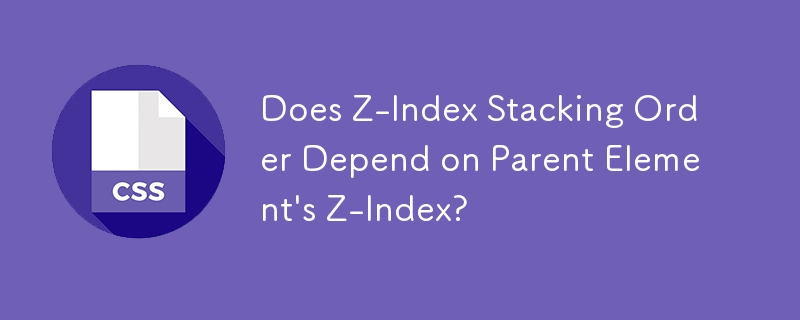Does Z-Index Stacking Order Depend on Parent Element\'s Z-Index?

Is the Z-Index Measurement of an Element Absolute or Relative?
The positioning of elements on a web page is determined by their z-index style. However, concerns have arisen regarding the absolute nature of their stack order or its relativity to their parent elements. This article aims to address these concerns within the context of browser implementation disparities.
Beginning with the established standards, z-index is indeed a relative property, signifying the stack order of an element relative to its immediate parent. This implies that an element's stacking behavior is influenced solely by its parent's z-index.
To illustrate this concept, consider the following scenario:
<code class="html"><div style="z-index:-100">
<div id="dHello" style="z-index:200">Hello World</div>
</div>
<div id="dDomination" style="z-index:100">I Dominate!</div></code>Based on the standards, #dHello should appear in front of #dDomination, as its z-index of 200 is higher than #dDomination's 100, despite its parent's negative z-index (-100).
However, browser implementations have introduced inconsistencies. In some browsers, the parent element's z-index is considered, even though it contradicts the official definition. Thus, #dDomination may appear in front of #dHello in such cases.
Variation in Browser Implementation:
- Internet Explorer: Previous versions disregarded the parent's z-index, while newer versions consider it.
- Firefox: Always considers the parent's z-index.
- Chrome and Safari: Typically follow the relative z-index model, but certain scenarios can lead to the parent's z-index being considered.
Conclusion:
Z-index is essentially a relative property. However, browser implementations may introduce variances in its behavior. For consistent results, it is recommended to use the relative model as described in the CSS specifications and be aware of possible browser-specific exceptions.
The above is the detailed content of Does Z-Index Stacking Order Depend on Parent Element\'s Z-Index?. For more information, please follow other related articles on the PHP Chinese website!

Hot AI Tools

Undresser.AI Undress
AI-powered app for creating realistic nude photos

AI Clothes Remover
Online AI tool for removing clothes from photos.

Undress AI Tool
Undress images for free

Clothoff.io
AI clothes remover

Video Face Swap
Swap faces in any video effortlessly with our completely free AI face swap tool!

Hot Article

Hot Tools

Notepad++7.3.1
Easy-to-use and free code editor

SublimeText3 Chinese version
Chinese version, very easy to use

Zend Studio 13.0.1
Powerful PHP integrated development environment

Dreamweaver CS6
Visual web development tools

SublimeText3 Mac version
God-level code editing software (SublimeText3)

Hot Topics
 Vue 3
Apr 02, 2025 pm 06:32 PM
Vue 3
Apr 02, 2025 pm 06:32 PM
It's out! Congrats to the Vue team for getting it done, I know it was a massive effort and a long time coming. All new docs, as well.
 Building an Ethereum app using Redwood.js and Fauna
Mar 28, 2025 am 09:18 AM
Building an Ethereum app using Redwood.js and Fauna
Mar 28, 2025 am 09:18 AM
With the recent climb of Bitcoin’s price over 20k $USD, and to it recently breaking 30k, I thought it’s worth taking a deep dive back into creating Ethereum
 Can you get valid CSS property values from the browser?
Apr 02, 2025 pm 06:17 PM
Can you get valid CSS property values from the browser?
Apr 02, 2025 pm 06:17 PM
I had someone write in with this very legit question. Lea just blogged about how you can get valid CSS properties themselves from the browser. That's like this.
 Stacked Cards with Sticky Positioning and a Dash of Sass
Apr 03, 2025 am 10:30 AM
Stacked Cards with Sticky Positioning and a Dash of Sass
Apr 03, 2025 am 10:30 AM
The other day, I spotted this particularly lovely bit from Corey Ginnivan’s website where a collection of cards stack on top of one another as you scroll.
 A bit on ci/cd
Apr 02, 2025 pm 06:21 PM
A bit on ci/cd
Apr 02, 2025 pm 06:21 PM
I'd say "website" fits better than "mobile app" but I like this framing from Max Lynch:
 Using Markdown and Localization in the WordPress Block Editor
Apr 02, 2025 am 04:27 AM
Using Markdown and Localization in the WordPress Block Editor
Apr 02, 2025 am 04:27 AM
If we need to show documentation to the user directly in the WordPress editor, what is the best way to do it?
 Comparing Browsers for Responsive Design
Apr 02, 2025 pm 06:25 PM
Comparing Browsers for Responsive Design
Apr 02, 2025 pm 06:25 PM
There are a number of these desktop apps where the goal is showing your site at different dimensions all at the same time. So you can, for example, be writing
 Why are the purple slashed areas in the Flex layout mistakenly considered 'overflow space'?
Apr 05, 2025 pm 05:51 PM
Why are the purple slashed areas in the Flex layout mistakenly considered 'overflow space'?
Apr 05, 2025 pm 05:51 PM
Questions about purple slash areas in Flex layouts When using Flex layouts, you may encounter some confusing phenomena, such as in the developer tools (d...






